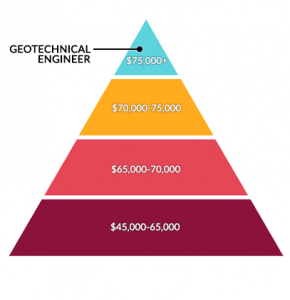Some Of Geotheta
Some Of Geotheta
Blog Article
The 10-Minute Rule for Geotheta
Table of Contents10 Simple Techniques For GeothetaGetting The Geotheta To WorkThe Best Strategy To Use For GeothetaGeotheta - QuestionsGeotheta Fundamentals Explained

They perform website investigations, collect examples, perform laboratory tests, and evaluate data to assess the viability of the ground for construction tasks - Consulting Engineers. Based upon their findings, geotechnical engineers supply recommendations for foundation layout, incline security, keeping structures, and mitigation of geotechnical dangers. They work together with other experts, such as architects, structural designers, and construction teams, to make certain that geotechnical considerations are incorporated right into the general task style and implementation
By analyzing the habits and residential or commercial properties of dirt and rock, they can identify potential geotechnical hazards such as landslides, dirt settlement, or incline instability. Their know-how aids avoid failures or crashes that can threaten lives and building. Below are some detailed tasks and obligations of a geotechnical engineer: Site Investigation: Geotechnical designers conduct site examinations to gather data on subsurface problems.
They analyze the information to understand the buildings and actions of the soil and rock, including their strength, leaks in the structure, compaction qualities, and groundwater conditions. Geotechnical Evaluation and Design: Geotechnical engineers analyze the data accumulated during site examinations to examine the stability and viability of the website for building jobs. They carry out geotechnical estimations and modeling to examine variables such as bearing ability, settlement, incline security, side planet pressures, and groundwater flow.
Facts About Geotheta Uncovered
Foundation Layout: Geotechnical engineers play a vital role in making foundations that can securely support the desired structure. They analyze the soil problems and tons demands to identify the ideal foundation kind, such as shallow foundations (e.g., grounds), deep foundations (e.g (https://fliphtml5.com/homepage/bdjcx/geotheta/)., heaps), or specialized strategies like soil renovation. They consider aspects such as settlement limits, birthing capacity, and soil-structure communication to create optimum structure designs
They evaluate construction strategies, monitor website activities, and conduct area examinations to verify that the design referrals are complied with. If unexpected geotechnical issues emerge, they examine the circumstance and provide referrals for remediation or changes to the design. Threat Evaluation and Mitigation: Geotechnical designers evaluate geotechnical threats and threats related to the job website, such as landslides, liquefaction, or dirt erosion.

Cooperation and Communication: Geotechnical designers work closely with various other professionals involved in a task, such as designers, structural engineers, and construction groups. Efficient communication and cooperation are important to integrate geotechnical factors to consider into the total job layout and building procedure. Geotechnical engineers give technical knowledge, solution questions, and ensure that geotechnical needs are met.
Some Ideas on Geotheta You Should Know
Below are some sorts of geotechnical engineers: Foundation Engineer: Foundation designers concentrate on designing and evaluating structures for structures. They analyze the dirt problems, load requirements, and site attributes to establish the most appropriate foundation kind and design, such as shallow foundations, deep foundations, or specialized strategies like heap structures.
They assess the elements influencing slope stability, such as soil residential or commercial properties, groundwater conditions, and slope geometry, and develop strategies to stop slope failures and mitigate risks. Earthquake Designer: Quake designers specialize in analyzing and creating structures to endure seismic forces. They assess the seismic hazard of a website, review soil liquefaction capacity, and develop seismic design criteria to make sure the safety and resilience of frameworks throughout earthquakes.
They carry out area screening, gather samples, and examine the accumulated data to characterize the dirt properties, geologic formations, and groundwater problems at a site. Geotechnical Instrumentation Designer: Geotechnical instrumentation engineers focus on surveillance and gauging the habits of dirt, rock, and frameworks. They install and maintain instrumentation systems that keep an eye on elements such as dirt settlement, groundwater degrees, slope movements, and architectural displacements to assess efficiency and offer very early cautions of potential concerns.
The Only Guide for Geotheta
They perform tests such as triaxial tests, loan consolidation tests, direct shear examinations, and permeability examinations to gather data for geotechnical analysis and layout. Geosynthetics Designer: Geosynthetics engineers specialize in the style and application of geosynthetic products, such as geotextiles, geogrids, and geomembranes. They use these materials to improve soil security, strengthen inclines, give water drainage remedies, and control erosion.
They have a tendency to be investigatory individuals, which suggests they're intellectual, reflective, and curious. They are interested, systematic, sensible, logical, and rational. Some of them are additionally social, implying they're kind, generous, cooperative, client, caring, helpful, compassionate, skillful, and friendly - Geo Tech Engineer.
In the office setting, geotechnical designers make use of specialized software devices to execute computations, develop styles, and examine information. They prepare records, testimonial project specs, communicate with customers and group members, and coordinate project activities. The office setting gives a conducive setting for study, analysis, and collaboration with various other specialists entailed in the job.
How Geotheta can Save You Time, Stress, and Money.
They regularly go to task sites to perform site examinations, analyze geotechnical conditions, and gather information for analysis. These gos to entail traveling to various locations, in some cases in remote or tough terrains. Geotechnical designers might do soil tasting, conduct tests, and screen building tasks to make certain that the geotechnical aspects of the job are being implemented properly.
Geotechnical designers also function in specialized geotechnical research laboratories. In these facilities, they carry out experiments, do tests on soil and rock samples, and analyze the design informative post residential properties of the materials. Geotechnical lab designers work extensively in these environments, taking care of testing equipment, operating instruments, and taping data. They collaborate with various other lab team to guarantee exact and dependable screening outcomes.
Report this page